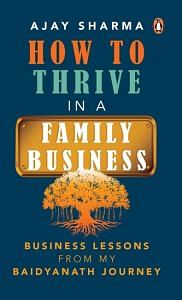Sanyas means complete renunciation. It comes from the Sanskrit word ‘Sam-nyas’. Sam means total, Nyas means abandonment. So complete abandonment is what Sanyas is. The definition of the word in Sanskrit elaborates that the perfect abandonment of one’s material, emotional and intellectual self is the true intent of Sanyas. In a business context, it is rather the abandonment of operations (material), of guidance and governance (intellectual) and ownership (emotional) that will help one attain Sanyas.
In the interest of the business, the next generation and self, it is advisable to denounce business and stay focused on the self. The act of relinquishment may be unique to each owner, and their actions can broadly be classified and attributed as:
i) Organized
ii) Self-centred
iii) Disorganized
On a lighter note, I would call them the good, the bad and the ugly of relinquishment. The good way is when the handover is planned and executed in a structured way, giving the three stakeholders (the business, the generation receiving and the generation handing over) clarity and security to blossom. Business requires progressive promoters and an able leader; the next generation looks for clarity of ownership and the relinquishing owner has to secure himself financially for the rest of his life. This is an ideal method and it is called a systematic and organized exit.
There are owners who think only about themselves and stay secretive regarding their next moves. This could be as drastic as selling the business or their stake to an outsider for personal monetary gains. This move is unfavourable and perceived as bad as it only takes into account the individual need of one stakeholder. The other two stakeholders, the business and the next generation, need to be part of the decision-making process as the three sets overlap each other. This is termed as a selfish exit.
The act of relinquishing becomes ugly when the owner abandons the business. Abandonment due to fatigue, terminal illness, death or indecision leaves behind chaos and conflicts. The owner is responsible for the business and the next generation. Leaving something midway without finishing the final handover of ownership is a disorganized exit. This could be due to unavoidable emergencies or, simply, indecision. It causes irreparable damage to the family business. The turn-in stage encourages and allows the owner to exit with eyes wide open.
Also Read: Something nearly tore Mariwala family apart. Timely IPO saved it from hostile takeover
If there is life after death, there is definitely life after total retirement. Till now, one has been working for money; now is the time when money has to work for you! You have just exited the drama company you owned and have also been replaced by a younger lead in the play.
You can sit in the audience and watch the play with the new lead performing and the new owner executing the business, or move out of the theatre and explore the outside world. The choice is entirely yours. You may want to delink or keep stalking the business. You are not old, so don’t behave like you are—you have a full stage ahead of you, so live your Sanyas.
In Maslow’s hierarchy of needs, self-actualization is at the top of the pyramid. What is self-actualization? When one feels satisfied at having achieved one’s potential, it is known as true self-actualization. It should not be linked to success and status which one has already acquired in Grihastha and Vanaprastha. It’s more holistic, encompassing ones psychological needs. A ‘bucket list’ is also a rudimentary example of attaining self-actualization. The creative side of every person has desires that need to be fulfilled; the first two sub-stages of Sanyas help one reach the final pinnacle of self-actualization and complete the need to attain self-satisfaction.
Following a passion is a common phenomenon. A friend of mine, a cardio surgeon, started walnut farming in the US. There are several others out there who start new ventures as a life-after-family-business backup—a true entrepreneurial mindset. My father-in-law, on the other hand, took a sabbatical; time off to relax and revisit his family heritage of Ramayana and Krishnayan, two epics written by his own grandfather. He also directed his earnings towards the renovation and reconstruction of dilapidated community structures such as parks, temples, shelters, etc. Truly a value-based decision! He tells me, ‘After denouncing business, work for a cause and not applause; seek happiness and shun selfishness as life in this stage has to be expressed and not impressed.’
Also Read: Entrepreneurs who turned their silver spoons gold
Detachment should not be perceived as a negative emotion. It is not a state of being estranged or having a lack of empathy. Turn-in, in fact, is positive—a state of calmness. The skill of shedding of desires avoids stress and maintains the mind and body balance. Detachment provides inner calm, an attitude of open-mindedness and a practical approach. Remember, you are in Sanyas and you have to ultimately become a sanyasi.
This stage helps you explore and awaken the creative potential that has been lying dormant. And if you do not forgo the business, you will not be able to awaken it or let go of the business. Only something that is extremely interesting and creative will help you get detached from business which has been your life for decades. It also works in reverse— if you don’t let the business go, you will never be able to explore the plethora of options awaiting you. But this is my own thinking and aspiration of my own Sanyas. But what’s natural in Sanyas is the ease of giving, not from a feeling of guilt or out of gratitude, but a sense of happiness.
So, the definition of creative is also not limited to what would be defined as conventionally creative. Sanyas is the stage which is truly yours. You have earned it after working all your life and it is up to you to make sure that you make the best use of this stage. The process of detachment is gratifying and takes one to another level of wisdom. It’s a positive state of well-being and happiness. Once you embrace Sanyas, you stop clinging to things. By the time one reaches old–old, truth has dawned upon them and one is more accepting towards the eventuality of life’s biggest truth, of life coming to an end.
Also Read: Running a family business? Here are 4 ways you can help the economy recover from Covid
Unfortunately, all cannot achieve this bliss; there are some who are constantly questioning themselves. How can I leave? I have no financial security. What will I do if I quit business? These are questions in Sanyas from a person who did not follow his Vanaprastha.
Owners cannot hand the business over because primarily, their own identity is so intermixed with the business, that they cannot see themselves without it. For some, the routine and relationships cannot be given up in one day and the thought of a sudden exit can be very disturbing. If transition was not followed during Vanaprastha, to let go at this age and stage becomes impossible.

This excerpt from ‘How to Thrive in a Family Business: Business Lessons from my Baidyanath Journey’ by Ajay Sharma has been published with permission from Penguin Portfolio, an imprint of Penguin Random House India.






